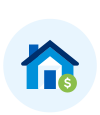Our competitive mortgage rates are backed by an experienced staff of mortgage professionals. We update the interest rate table below daily, Monday through Friday, so you have the most current refinance rates available. Use our mortgage calculator to get a customized estimate of your mortgage rate and monthly payment. Try our Home Value Estimator to discover your home's value. For our current mortgage purchase rates, go to Mortgage Purchase Rates.
Want to know Mortgage rates for refinance?
Please tell us your ZIP code to see your local rates.
Mortgage refinance rates, explained
Refinance rates are the interest rates lenders offer when you’re replacing your current mortgage with a new loan, often with different terms or conditions. As such, refinance rates may be higher or lower than the original mortgage rate, depending on market conditions and your financial circumstances.
When to refinance your mortgage
There are various reasons you might consider refinancing, including the potential for lower refinance rates or due to a significant change in your finances. Let’s look at a few reasons some homeowners might explore mortgage refinancing:
Lower rates
A big reason to refinance is to help secure a lower interest rate. By lowering your rate, you can potentially reduce both the size of your monthly payments and the total interest you pay over the lifetime of the loan.
Shorter terms
Another reason is to shorten the terms of your mortgage. This could mean moving from a 30-year to a 15-year mortgage, for example. While reducing your mortgage term could potentially increase what you pay monthly, it may also substantially decrease the amount of interest you pay overall.
Removing PMI
Typically, you can remove private mortgage insurance (PMI) once you reach 20% equity in your home. If your home's value has gone up since you got your loan, you might now own 20% of its value, even if you haven't paid down the loan to that level. This happens because the higher home value lowers your loan-to-value ratio, increasing your equity percentage without you having to make extra payments on the loan.
How to get a better mortgage refinance rate
When homeowners seek to refinance, securing a better rate is often a top priority. The way to get a lower refinance rate can vary based on individual circumstances, but there are few general tips that may help:
- Improving your credit: Your credit score is a major factor that lenders consider when determining your refinance rate. Generally, higher credit scores may help qualify you for lower interest rates. Improving your credit score by paying bills on time, reducing debt and correcting any inaccuracies in your credit report can be a helpful first step before you refinance.
- Comparing multiple rates: Different lenders evaluate refinance applications differently, so getting multiple quotes may help you find more competitive rates. It might be wise to note the annual percentage rate (APR), as that includes the interest rate along with any fees the lender charges to give you a clearer picture of your expected annual costs of borrowing.
- Timing your application: Mortgage refinance rates fluctuate based on economic conditions and market trends. Keeping an eye on these trends may give you an opportunity to refinance when rates are generally lower, potentially saving you money over the life of your loan.
- Evaluating different terms: Different loan terms offer different rates. For example, shorter loan terms tend to carry lower interest rates compared to longer terms but with higher monthly payments. Depending on your financial situation, choosing a shorter term might be a cost-effective decision if you can manage the higher monthly expenses.
Learn about mortgage rates
Mortgage rates are the rate of interest that is charged on a mortgage. Calculated by your lender, mortgage rates can either be fixed for the length of your mortgage or adjustable based on the current market.

Based on a number of factors, mortgage rates are indicators of the level of risk a potential homebuyer presents to a lender. The higher the risk, the higher the mortgage rate. Qualified homebuyers can find lower mortgage rates by having a good credit score, a higher down payment and shorter loan terms.

Mortgage interest rates are just one part of your mortgage and they are often confused with annual percentage rate. Learn more about how interest rates differ from APRs.

Locking in an interest rate is also an option to ensure a lower mortgage rate. However, as mortgage rates change daily, work with your Home Lending Advisor to secure a rate for your budget and mortgage.
Mortgage refinance rates resources
Mortgage interest rate vs. APR

Learn the difference between mortgage interest rates and APRs or annual percentage rates.
7 ways to reduce mortgage rates

Whether you're shopping for mortgages, close to signing or a few years into yours, there are always ways to reduce your monthly payments.
When can you refinance a mortgage?

Read the factors you should first consider when determining if refinancing makes sense for you.
How to use a mortgage calculator

Follow this step-by-step guide for calculating your estimated mortgage payments.
Helpful tools
Financing a home can be easy when you know how. Browse our tools, resources and articles for help understanding how buying a home, refinancing a mortgage and tapping into your home's equity works.
Mortgage refinance rates FAQs
Yes, you can refinance a fixed-rate mortgage. Refinancing allows you to effectively replace your existing mortgage with a new one, potentially with different terms, a lower interest rate or a different type of mortgage. Many homeowners refinance to adjust their mortgage according to changes in their financial situation or market conditions.
While many homeowners refinance to secure a lower rate, it is possible to refinance and keep the same interest rate. This could be beneficial if other terms, such as loan duration or the type of rate (such as opting for a fixed-rate over an adjustable mortgage4 are better suited for your current financial circumstances. However, this may not always be the case due to market conditions. There can be options for a customer to buydown the rate, if rates have increased.
Yes, you can refinance an adjustable-rate mortgage (ARM). Some choose to replace their ARM with a fixed-rate mortgage to obtain a more stable and predictable monthly payment.
Refinance rates and mortgage rates may be similar but are not always identical,. Lenders might offer slightly different rates for refinancing compared to those for new home purchases, depending on various factors including market conditions, borrower creditworthiness and lender policies.
Refinancing when interest rates drop might be advantageous if the new rate significant lowers your monthly payment, reduces the overall interest cost or helps adjust the loan term to better suit your financial goals. Speaking with a qualified home lending advisor can help yu determeine if refinancing makes sense for you and your unique financial situation.

